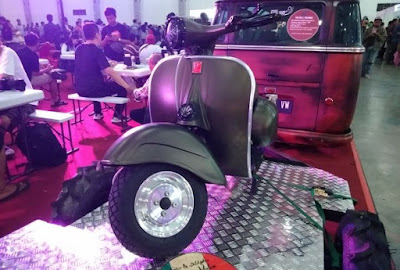The idea of making a vehicle modification work can come from anywhere. The following is a modified scooter that is very unique at the Indonesian Scooter Festival (ISF) 2018. At this event, a variety of modified scooters were displayed. One of the Vespa who draw attention at the event was a modified scooter made by Kupu-Kupu Malam Workshop, a famous automotive modification house from Yogyakarta.
 |
| Vescop (Vespa Choptop Airsus) built by Kupu-Kupu Malam Workshop taken of 1964 Vespa VBA. (Picture from: http://bit.ly/2y4CxWs) |
Of course this is rare because an air suspension system is generally installed on a car. And the unique the air suspension used on this scooter is a pneumatic type. Yes, on the front and back legs of the scooter is installed IDONE's airsuspension. For the system itself it turns out that it is almost similar to the one in the car and meanwhile to operate it by using a remote control.
 |
| Vescop (Vespa Choptop Airsus) by Kupu-Kupu Malam Workshop shown at the Indonesian Scooter Festival (ISF) 2018. (Picture from: http://bit.ly/2y4CxWs) |
 |
| The air suspension used on the Vescop (Vespa Choptop Airsus) is a pneumatic type. There're also seen Vespa PX forks combined with 8-inch rims with disc braking system. (Picture from: http://bit.ly/2y4CxWs) |
 |
| The air suspension compressor used on the Vescop (Vespa Choptop Airsus) installed burst out of the body. (Picture from: http://bit.ly/2y4CxWs) |
While on the legs, this scooter uses an 8-inch rim from S.I.P which is then wrapped with Swallow tires. Then to be able to withstand the speed of this scooter, disc brakes were installed from Temaca.
 |
| Besides the IDONE air suspension compressor mounted out on the left, so does the Koso PWK 28 carburetor on the right. (Picture from: http://bit.ly/2OH06hq) |
Are you interested in making your scooter to be an air suspension ones? If you want, then prepare your money roughly US. $5,300 (or approx Rp.80 millions) as your scooter modification fees, then bring the scooter to the Kupu-Kupu Malam Workshop in Yogyakarta, Indonesia. (Wanna see another automotive works of the Kupu-Kupu Malam Workshop!)
Note: This blog can be accessed via your smart phone






































